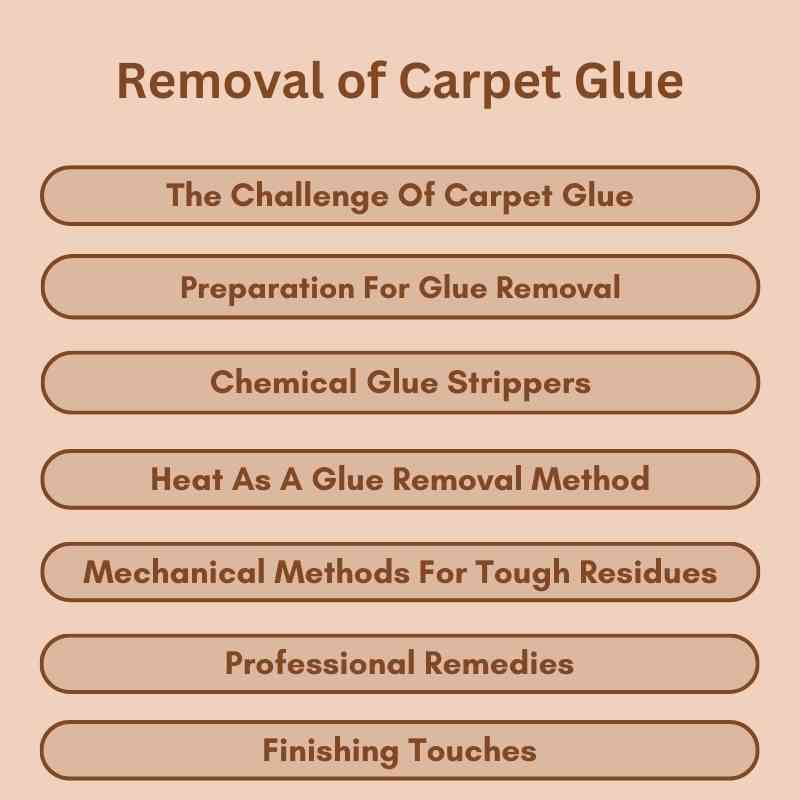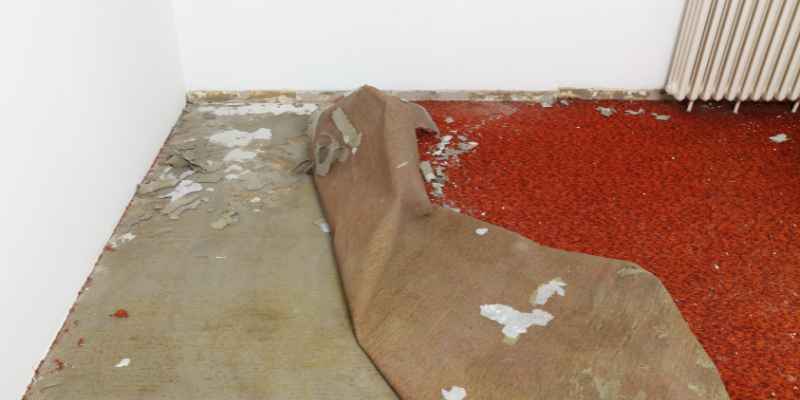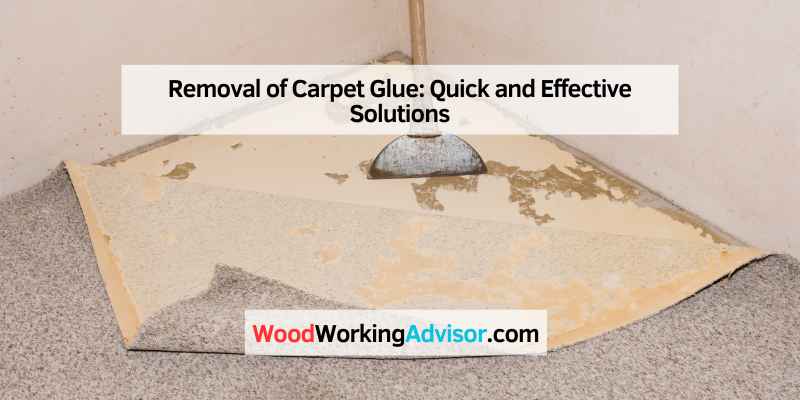To remove carpet glue effectively, use a combination of heat and adhesive remover. Scrape off the softened glue with a putty knife for best results.
Carpet glue can be stubborn, making removal a challenging task. Homeowners often face difficulties when trying to restore their floors after carpet installation. Understanding the right techniques and materials is crucial for successful removal. Various methods exist, including using heat, solvents, or scraping tools.
Each approach has its pros and cons, depending on the glue type and the surface beneath. Choosing the correct method not only saves time but also prevents damage to your flooring. Whether you are prepping for new flooring or simply renovating, removing carpet glue properly sets the stage for a smooth and successful project.
The Challenge Of Carpet Glue
Removing carpet glue can be a tough task. This adhesive is designed to last. Many homeowners struggle with stubborn residue. It sticks strongly to floors and carpets.
Common types of carpet adhesives include:
| Type | Description |
|---|---|
| Latex Adhesive | Water-based and easy to clean up. |
| Urethane Adhesive | Strong and moisture-resistant. |
| Pressure-sensitive Adhesive | Peel-and-stick, easy to apply. |
| Solvent-based Adhesive | Very strong but hard to remove. |
Understanding these types helps in choosing the right removal method.

Preparation For Glue Removal
Safety is very important during carpet glue removal. Always wear protective gear. This includes gloves, goggles, and a mask. These items keep you safe from harmful chemicals.
Before starting, clear the work area. Remove all furniture and items from the space. This helps you move easily and safely.
| Tools | Materials |
|---|---|
| Scraper | Carpet adhesive remover |
| Putty knife | Rags or towels |
| Bucket | Warm water |
Gather all the tools and materials you need. This makes the process faster and easier.
Natural Solutions For Glue Removal
Vinegar is a great choice for removing carpet glue. It is eco-friendly and safe to use. Mix equal parts of vinegar and water in a spray bottle. Spray the solution on the glue. Let it sit for a few minutes. Then, use a scraper to remove the glue easily.
Baking soda and water also work well together. Create a paste using baking soda and water. Apply the paste to the glue spots. Allow it to dry completely before scraping it off. This method is simple and effective.
Chemical Glue Strippers
Selecting the right chemical stripper is crucial for effective carpet glue removal. Look for products that specifically target adhesives and are safe for your floor type. Always test a small area first to ensure no damage occurs.
Application techniques can vary. Use a paintbrush or roller to apply the stripper evenly. Follow the manufacturer’s instructions for the best results. Allow it to sit for the recommended time before scraping.
Safety is essential. Wear gloves and goggles to protect your skin and eyes. Ensure proper ventilation by opening windows or using fans. Clean up spills immediately with soap and water.
Dispose of any leftover chemical safely. Follow local regulations for hazardous waste disposal.
Heat As A Glue Removal Method
Using a heat gun can effectively remove carpet glue. It softens the glue, making it easier to scrape off. Always wear safety goggles and gloves for protection.
Keep the heat gun at least 6 inches away from the surface. Move it slowly to avoid burning the carpet or floor. Test a small area first to check results.
Another method is ironing out the glue. Place a clean cloth over the glue. Use a low-heat iron for about 10 seconds. Lift the cloth to check if the glue has softened.
Repeat this process until the glue is removed. Ensure the area cools before scraping off any residue.
Mechanical Methods For Tough Residues
Scraping is a simple method for removing carpet glue. It requires manual effort. Use a putty knife or a scraper for best results. Work slowly and carefully. This helps avoid damaging the floor underneath. Repeat the process until no glue remains.
Power tools can speed up the removal process for tough residues. An oscillating tool or a floor scraper works well. These tools can save time and reduce physical effort. Always wear safety gear like goggles and gloves. Ensure to follow the tool’s instructions for safe use.
Professional Remedies
Hiring professionals for carpet glue removal is a smart choice. They have the right tools and experience. Knowing when to call in the pros is key. If the glue is too tough, it’s time to seek help.
Signs that professional help is needed include:
- Extensive glue coverage
- Stains that won’t come out
- Damage to the subfloor
Services offered by professionals may include:
| Service | Description |
|---|---|
| Glue Removal | Safe and effective removal of all types of glue. |
| Subfloor Repair | Fixing any damage caused by glue removal. |
| Surface Preparation | Preparing the area for new flooring. |
Finishing Touches
After removing carpet glue, it’s vital to smooth the surface. Use a floor scraper to eliminate any remaining residue. A sander can help create an even surface. Ensure the area is clean before proceeding.
For the final cleaning, sweep the floor to remove dust and debris. A damp mop will help catch any leftover particles. Allow the floor to dry completely before applying new flooring.
Disposing of the carpet glue requires care. Check local regulations for proper disposal methods. Some glue types may need special handling. Use sealed bags to contain any glue remnants.
Preventative Measures For The Future
Choosing the right adhesives is very important for carpet installation. Use water-based adhesives for easier removal later. They are less likely to damage your floor. Always read the product label before purchasing.
Install and remove carpets with care to avoid glue problems. Follow the manufacturer’s guidelines for best results. Use tools that prevent glue from spreading. Keep the area well-ventilated during installation.
Consider these tips:
- Test the adhesive on a small area first.
- Choose products that are easy to clean up.
- Check for low-VOC options for better air quality.
Troubleshooting Common Issues
After removing carpet, residue often remains. This sticky substance can be tough to clean. Use a scraper to gently lift off large pieces. For smaller bits, a solvent may help dissolve the glue.
Discoloration can happen on the floor after glue removal. To fix this, clean the area with warm, soapy water. A mixture of vinegar and water can also be effective. Always test a small area first to avoid further damage.
| Cleaning Method | Effectiveness |
|---|---|
| Scraper | Good for large chunks |
| Solvent | Effective for smaller residues |
| Soapy Water | Helps with discoloration |
| Vinegar Solution | Safe and natural cleaner |

Frequently Asked Questions
How Can I Remove Carpet Glue Effectively?
To remove carpet glue effectively, start by scraping off excess glue using a putty knife. Apply a commercial adhesive remover or a mixture of vinegar and water. Let it sit for a few minutes to penetrate. Scrub gently with a brush, then wipe clean with a damp cloth.
What Are The Best Tools For Carpet Glue Removal?
The best tools for carpet glue removal include a putty knife, scraper, and adhesive remover. Additionally, a steam cleaner can help soften the glue. A brush with stiff bristles can effectively scrub away residue. Always wear protective gloves to ensure safety during the process.
Is It Safe To Use Vinegar For Glue Removal?
Yes, using vinegar for glue removal is safe and effective. It is a natural solvent that helps break down adhesive residues. Mix equal parts vinegar and water, then apply it to the glue. Allow it to sit for a few minutes before scrubbing.
This method is eco-friendly and non-toxic.
How Long Does Glue Removal Take?
The time required for glue removal varies based on the glue type and area size. Generally, it can take anywhere from 30 minutes to a few hours. Factors like drying time for removers also play a role. Patience and thoroughness yield the best results for a clean surface.
Conclusion
Removing carpet glue can be a straightforward task with the right approach. Always gather the necessary tools and materials before starting. Patience is key for effective results. By following the steps outlined, you can restore your floors without hassle. A clean surface will enhance your space and make it ready for your next project.

